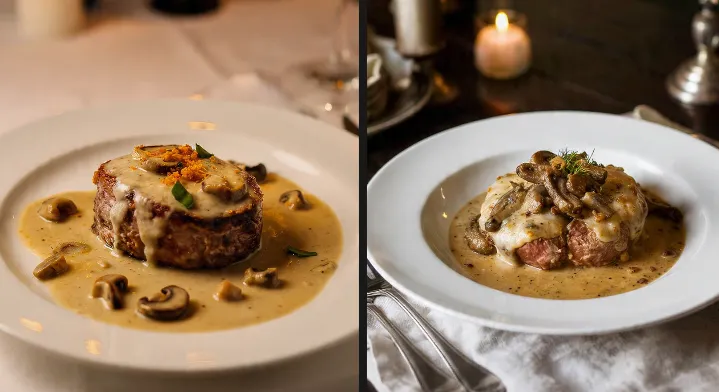Steak Diane is a timeless classic that brings the elegance of mid-century fine dining into the modern kitchen. This dish features tender, pan-seared steak medallions served with a luxurious sauce made from cognac, Dijon mustard, cream, and mushrooms. The sauce is flambéed for depth and drama, creating a rich, velvety coating that perfectly complements the beef.
Once a staple of upscale restaurants and tableside service, Steak Diane remains a symbol of sophistication and indulgence. It’s a dish that feels extravagant yet approachable, perfect for romantic dinners, celebrations, or when a touch of old-world charm is desired.
The Essence of Steak Diane
The essence of Steak Diane lies in its balance of flavors — the savory richness of the beef, the tang of Dijon mustard, the sweetness of cognac, and the creaminess of the sauce. The dish is traditionally prepared tableside, where the sauce is flambéed for a touch of theater. The result is a meal that’s both visually stunning and deeply satisfying.
It’s a dish that captures the glamour of classic dining while remaining simple enough to prepare at home.
Why This Recipe Works
This recipe works because it layers flavors through searing, deglazing, and reduction. The steak is seared to develop a caramelized crust, then removed while the pan is used to build the sauce. The cognac deglazes the pan, lifting the flavorful browned bits, while the cream and mustard create a smooth, rich finish.
The result is a perfectly cooked steak coated in a sauce that’s bold, balanced, and irresistibly silky.
Ingredients and Their Roles
Steak medallions (beef tenderloin or sirloin): The main protein, tender and flavorful.
Salt and black pepper: Essential for seasoning.
Butter and olive oil: Used for searing and adding richness.
Shallots and garlic: Add aromatic depth.
Mushrooms: Provide earthiness and texture.
Cognac or brandy: Deglazes the pan and adds complexity.
Dijon mustard: Adds tang and sharpness.
Worcestershire sauce: Enhances umami flavor.
Heavy cream: Creates a smooth, velvety sauce.
Fresh parsley: Adds color and freshness.
Step-by-Step Recipe
Ingredients
- 2 beef tenderloin steaks (about 6 ounces each)
- Salt and freshly ground black pepper, to taste
- 1 tablespoon olive oil
- 2 tablespoons butter, divided
- 1 shallot, finely chopped
- 1 cup sliced mushrooms
- 1 clove garlic, minced
- ¼ cup cognac or brandy
- 1 teaspoon Dijon mustard
- 1 teaspoon Worcestershire sauce
- ½ cup heavy cream
- 1 tablespoon chopped fresh parsley
Preparation
- Prepare the steaks. Pat the steaks dry with paper towels and season both sides with salt and pepper.
- Sear the steaks. Heat olive oil and 1 tablespoon butter in a large skillet over medium-high heat. Add the steaks and sear for 3–4 minutes per side for medium-rare, or until the internal temperature reaches 130°F (54°C). Transfer to a plate and cover loosely with foil.
- Sauté the aromatics. In the same skillet, add the remaining butter. Add shallots and mushrooms, cooking for 3–4 minutes until softened and golden. Add garlic and cook for 30 seconds until fragrant.
- Deglaze with cognac. Carefully add the cognac or brandy to the pan. If desired, flambé by tilting the pan slightly to ignite the alcohol (optional). Let the flames subside naturally.
- Build the sauce. Stir in Dijon mustard and Worcestershire sauce, scraping up any browned bits from the bottom of the pan. Add the cream and simmer for 2–3 minutes until the sauce thickens slightly.
- Return the steaks. Place the steaks back into the pan, spooning the sauce over them. Simmer for 1–2 minutes to warm through.
- Serve. Garnish with chopped parsley and serve immediately with the sauce spooned over the top.
Tips for Perfect Steak Diane
- Use tender cuts like filet mignon or sirloin for the best texture.
- Don’t overcook the steak; medium-rare is ideal for tenderness.
- Deglaze carefully if flambéing — keep a lid nearby for safety.
- Let the sauce reduce gently for a smooth, creamy texture.
- Serve immediately for the best flavor and presentation.
Variations and Flavor Combinations
1. Classic Steak Diane
Traditional version with cognac, cream, and Dijon mustard.
2. Mushroom Steak Diane
Add extra mushrooms for a heartier sauce.
3. Peppercorn Steak Diane
Add crushed peppercorns for a spicy twist.
4. Red Wine Steak Diane
Replace cognac with red wine for a deeper flavor.
5. Garlic Herb Steak Diane
Add fresh thyme or rosemary for aromatic depth.
6. Lightened-Up Steak Diane
Use half-and-half instead of cream for a lighter version.
Serving Suggestions
Steak Diane pairs beautifully with:
- Mashed potatoes or roasted garlic potatoes.
- Buttered noodles or rice pilaf.
- Steamed asparagus or green beans.
- Creamed spinach or sautéed mushrooms.
- A glass of red wine, such as Cabernet Sauvignon or Merlot.
Make-Ahead and Storage
Make-ahead: Prepare the sauce in advance and reheat gently before serving.
Storage: Store leftover steak and sauce separately in airtight containers in the refrigerator for up to 2 days.
Reheating: Reheat gently in a skillet over low heat to preserve tenderness.
Freezing: Not recommended, as the cream sauce may separate.
Nutritional Information (per serving)**
- Calories: 520 kcal
- Protein: 40 g
- Fat: 36 g
- Carbohydrates: 5 g
- Sugar: 2 g
The History of Steak Diane
Steak Diane originated in mid-20th-century New York and London restaurants, where it was often prepared tableside for an air of sophistication. The dish was named after Diana, the Roman goddess of the hunt, symbolizing its connection to game and fine dining. Its flambéed sauce and elegant presentation made it a favorite among celebrities and socialites of the era.
Today, Steak Diane remains a beloved classic, representing the golden age of dining with its rich flavors and timeless appeal.
Texture and Flavor Profile
The perfect Steak Diane has a tender, juicy steak coated in a creamy, flavorful sauce. The cognac adds warmth and depth, the mustard provides tang, and the cream ties everything together with smooth richness. The mushrooms add earthiness, while the shallots and garlic bring aromatic balance.
Each bite delivers contrast — tender meat, silky sauce, and a hint of spice from the mustard.
Common Mistakes and How to Avoid Them
Overcooking the steak: Makes it tough. Use a thermometer for accuracy.
Boiling the sauce: Can cause separation. Simmer gently.
Using too much alcohol: Overpowers the dish. Let it reduce properly.
Skipping the rest period: Causes juices to run out. Always rest before serving.
Adding cream too early: Can curdle. Add after deglazing.
Chef’s Tips
- Use high-quality cognac or brandy for the best flavor.
- Add a splash of lemon juice for brightness.
- Strain the sauce for a smooth, restaurant-style finish.
- Serve on warm plates to keep the dish hot.
- Garnish with microgreens or parsley for color.
Pairing Ideas
With Drinks:
- Cabernet Sauvignon or Merlot.
- Pinot Noir for a lighter pairing.
- Sparkling water with lemon.
With Other Dishes:
- Pair with roasted potatoes or truffle fries.
- Serve alongside grilled vegetables or salad.
- Include in a multi-course dinner with soup or dessert.
The Joy of Classic Cooking
Steak Diane is a dish that celebrates the joy of classic cooking — simple ingredients elevated through technique and care. The sizzle of the steak, the aroma of cognac and cream, and the rich sauce coming together create a sensory experience that’s both nostalgic and luxurious.
It’s a dish that feels indulgent yet comforting, perfect for both special occasions and quiet nights at home.
The Science of the Sauce
The magic of Steak Diane’s sauce lies in emulsification and reduction. The cognac deglazes the pan, lifting flavorful browned bits, while the cream and butter emulsify to create a smooth, velvety texture. The mustard and Worcestershire sauce add acidity and umami, balancing the richness.
The result is a sauce that’s glossy, flavorful, and perfectly coats the steak.
Presentation and Finishing Touches
For an elegant presentation, serve the steak on a warm plate with the sauce drizzled over the top. Garnish with fresh parsley or thyme. Add a side of mashed potatoes or roasted vegetables for a complete meal.
For a restaurant-style touch, spoon the sauce in a circular pattern around the steak and finish with a drizzle of melted butter.
Modern Variations
- Keto Steak Diane: Naturally low-carb and high in protein.
- Gluten-Free Version: Naturally gluten-free when using gluten-free Worcestershire sauce.
- Dairy-Free Version: Use coconut cream instead of heavy cream.
- Filet Diane: Use filet mignon for an extra-tender version.
- Chicken Diane: Substitute chicken breasts for a lighter alternative.
The Perfect Dinner
Steak Diane is the ultimate dinner for those who appreciate classic flavors and elegant presentation. It’s rich, flavorful, and satisfying, with a perfect balance of savory, creamy, and tangy notes. Ready in under 30 minutes, it’s ideal for weeknight dinners, date nights, or entertaining guests.
It’s also versatile — serve it with potatoes for comfort or a crisp salad for freshness.
The Cultural Influence of Steak Diane
Steak Diane reflects the glamour of mid-century dining, when tableside flambéing and rich sauces defined sophistication. Its enduring popularity speaks to its timeless appeal — a dish that combines French technique with American flair. Today, it remains a favorite in steakhouses and home kitchens alike.
The Role of Cognac and Mustard
Cognac and mustard are the heart of this dish. The cognac adds warmth and depth, while the mustard provides tang and brightness. Together, they create a sauce that’s complex yet balanced, enhancing the steak’s natural flavor without overpowering it.
The Perfect Bite
The perfect bite of Steak Diane combines tender, juicy steak with a creamy, flavorful sauce infused with cognac, mustard, and mushrooms. The flavors are rich and layered, the textures smooth and satisfying. It’s a dish that delights the senses and feels both comforting and refined.
Conclusion
Steak Diane is a celebration of elegance, flavor, and tradition. With its tender steak, creamy cognac sauce, and perfect balance of richness and tang, it’s a dish that transforms any meal into a special occasion.
Quick to prepare yet impressive to serve, this recipe is perfect for date nights, holidays, or whenever a touch of luxury is desired. Whether paired with mashed potatoes, vegetables, or a glass of red wine, it proves that great food doesn’t need to be complicated — just quality ingredients, thoughtful preparation, and a touch of care.






